Interconnected Pathways: Postural Stability and Vocabulary Skills in Preschool-Aged Children
Abstract
1. Introduction
This Study
2. Materials and Methods
2.1. Participants
2.2. Procedure
- A (+) is marked in the box “1, answer given without help” when the child answers correctly without help.
- A (−) is marked in the box “1, answer given without help” when the child does not answer. If, on the other hand, he gives an unexpected answer, write the answer produced in the space “answer provided”.
- A (+) is marked in box “2, answer provided with semantic help” if the child responds correctly to the semantic help given by the examiner.
- A (+) is marked in box “3, answer provided with phonological help” if the child responds correctly to the phonological help given by the examiner. Each (+) sign is worth 1 point; each (−) sign is worth 0 points. By summing the answers, it is possible to obtain a raw total score of the correct answers without help, with semantic help, and with phonological help.
2.3. Statistical Analysis
3. Results
3.1. Descriptive Statistics
3.2. Missing Data Inspection
3.3. Multilevel Regression Analysis
3.4. Inter-Domain Network Analysis
4. Discussion
5. Conclusions
Supplementary Materials
Author Contributions
Funding
Institutional Review Board Statement
Informed Consent Statement
Data Availability Statement
Acknowledgments
Conflicts of Interest
References
- Thelen, E. Motor development—A new synthesis. Am. Psychol. 1996, 50, 79–95. [Google Scholar] [CrossRef]
- Wellsby, M.; Pexman, P.M. Developing embodied cognition: Insights from children’s concepts and language processing. Front. Psychol. 2014, 5, 506. [Google Scholar] [CrossRef] [PubMed]
- Westermann, G.; Mareschal, D.; Johnson, M.H.; Sirois, S.; Spratling, M.W.; Thomas, M.S. Neuroconstructivism. Dev. Sci. 2007, 10, 75–83. [Google Scholar] [CrossRef]
- Kuhl, P.K. Early language acquisition: Cracking the speech code. Nat. Rev. Neurosci. 2004, 5, 831–843. [Google Scholar] [CrossRef] [PubMed]
- Walle, E.A. Infant social development across the transition from crawling to walking. Front. Psychol. 2016, 7, 960. [Google Scholar] [CrossRef] [PubMed]
- Gonzalez, S.L.; Alvarez, V.; Nelson, E.L. Do gross and fine motor skills differentially contribute to language outcomes? A systematic review. Front. Psychol. 2019, 10, 2670. [Google Scholar] [CrossRef]
- Iverson, J.M. Learning to talk in a gesture-rich world: Early communication in Italian vs. English. Child Dev. 2022, 93, 14–29. [Google Scholar]
- Libertus, K.; Needham, A. Reaching experience increases face preference in 3-month-old infants. Dev. Sci. 2016, 19, 50–59. [Google Scholar] [CrossRef]
- Iverson, J.M. Developing language in a developing body: The relationship between motor development and language development. J. Child Lang. 2010, 37, 229–261. [Google Scholar] [CrossRef]
- Iverson, J.M. Developmental variability and developmental cascades: Lessons from motor and language development in infancy. Curr. Dir. Psychol. Sci. 2021, 30, 228–235. [Google Scholar] [CrossRef]
- West, K.L. Infant motor development in autism spectrum disorder: A synthesis and meta-analysis. Child 2019, 90, 2053–2070. [Google Scholar] [CrossRef]
- Tomasello, R. Linguistic signs in action: The neuropragmatics of speech acts. Brain Lang. 2023, 236, 105203. [Google Scholar] [CrossRef]
- Fleck, L.; Fuchs, A.; Kaess, M. The Significance of Relationships in Developmental Psychopathology and Youth Mental Health. Psychopathology 2023, 56, 5–7. [Google Scholar] [CrossRef] [PubMed]
- Wang, M.V.; Lekhal, R.; Aarø, L.E.; Schjølberg, S. Co-occurring development of early childhood communication and motor skills: Results from a population-based longitudinal study. Child 2014, 40, 77–84. [Google Scholar] [CrossRef] [PubMed]
- Gonzalez, C.L.; Mills, K.J.; Genee, I.; Li, F.; Piquette, N.; Rosen, N.; Gibb, R.L. Getting the right grasp on executive function. Front. Psychol. 2019, 10, 441. [Google Scholar] [CrossRef] [PubMed]
- Wassenberg, R.; Feron, F.J.M.; Kessels, A.G.H.; Hendriksen, J.G.M.; Kalff, A.C.; Kroes, M.; Hurks, P.P.M.; Beeren, M.; Jolles, J.; Vles, J.S.H. Relation Between Cognitive and Motor Performance in 5 to 6 Year Old Children: Results from a Large Scale Cross Sectional Study. Child Dev. 2005, 76, 1092–1103. [Google Scholar] [CrossRef] [PubMed]
- Wang, M.; Lekhal, R.; Aarø, L.; Holte, A.; Schjølberg, S. The developmental relationship between language and motor performance from 3 to 5 years of age: A prospective longitudinal population study. BMC Psychol. 2014, 2, 1–10. [Google Scholar] [CrossRef]
- Archibald, L.M.; Alloway, T.P. Comparing language profiles: Children with specific language impairment and developmental coordination disorder. Int. J. Lang. Commun. Disord. 2008, 43, 165–180. [Google Scholar] [CrossRef]
- Hill, J.L.; Romano, Z.; Goffin, C.; Keown, L.J.; Boon, H. Video feedback intervention: A case series in the context of childhood emotional and behavioral difficulties. Child Fam. Behav. Ther. 2001, 23, 13–28. [Google Scholar]
- Iverson, J.M.; Braddock, B.A. Gesture and motor skill in relation to language in children with language impairment. J. Speech Lang. Hear. Res. JSLHR 2011, 54, 72–86. [Google Scholar] [CrossRef]
- Rechetnikov, R.P.; Maitra, K. Motor impairments in children associated with impairments of speech or language: A meta-analytic review of research literature. Am. J. Occup. Ther. 2009, 63, 255–263. [Google Scholar] [CrossRef]
- Webster, R.I.; Majnemer, A.; Platt, R.W.; Shevell, M.I. Motor function at school age in children with a preschool diagnosis of developmental language impairment. J. Pediatr. 2005, 146, 80–85. [Google Scholar] [CrossRef]
- Smyth, R.H. Memory attentional processes in children with speech language impairments. In Handbook of Neuropsychology; Segalowitz, S.J., Rapin, I., Eds.; Elsevier: Amsterdam, The Netherlands, 1992; Volume 7, pp. 75–107. [Google Scholar]
- Hill, E.L. A dyspraxic deficit in specific language impairment and developmental coordination disorder? Evidence from hand and arm movements. Dev. Med. Child Neurol. 1998, 40, 388–395. [Google Scholar] [CrossRef] [PubMed]
- Ladányi, E.; Lukács, Á. Action prediction in children with developmental language disorder. J. Exp. Child Psychol. 2020, 189, 104681. [Google Scholar]
- Justice, L.M.; Petscher, Y.; Schatschneider, C.; Mashburn, A. Peer effects in preschool classrooms: Is children’s language growth associated with their classmates’ skills? Child Dev. 2011, 82, 1768–1777. [Google Scholar] [CrossRef] [PubMed]
- Gallahue, D.; Ozmun, J. Understanding Motor Development: Infants, Children, Adolescents, Adults; McGraw-Hill: New York, NY, USA, 2006. [Google Scholar]
- Lorefice, L.E.; Galea, M.P.; Clark, R.A.; Doyle, L.W.; Anderson, P.J.; Spittle, A.J. Postural control at 4 years in very preterm children compared with term-born peers. Dev. Med. Child Neurol. 2015, 57, 175–180. [Google Scholar] [CrossRef] [PubMed]
- Kim, H.; Carlson, A.G.; Curby, T.W.; Winsler, A. Relations among motor, social, and cognitive skills in pre-kindergarten children with developmental disabilities. Res. Dev. Disabil. 2016, 53, 43–60. [Google Scholar] [CrossRef]
- Travers, B.G.; Powell, P.S.; Klinger, L.G.; Klinger, M.R. Motor difficulties in autism spectrum disorder: Linking symptom severity and postural stability. J. Autism Dev. Disord. 2013, 43, 1568–1583. [Google Scholar] [CrossRef]
- Clark, J.E.; Whitall, J. Developmental coordination disorder: It’s not just the motor. Adapt. Phys. Act. Q. 2007, 24, 115–135. [Google Scholar]
- Linville, R.N.; Folkins, J.W. Temporal characteristics of repeated utterances. J. Acoust. Soc. Am. 1982, 71, S113. [Google Scholar] [CrossRef]
- Moreno, M.A.; Stepp, N.; Turvey, M.T. Whole body lexical decision. Neurosci. Lett. 2011, 490, 126–129. [Google Scholar] [CrossRef] [PubMed]
- Rodriguez, A.D.; McCabe, M.L.; Nocera, J.R.; Reilly, J. Concurrent word generation and motor performance: Further evidence for language-motor interaction. PLoS ONE 2012, 7, e37094. [Google Scholar] [CrossRef] [PubMed][Green Version]
- Tilsen, S. Selection and coordination: The articulatory basis for regular speech patterns. J. Phon. 2016, 55, 77–95. [Google Scholar] [CrossRef]
- Liang, H.; Beerse, M.; Ke, X.; Wu, J. Effect of whole-body vibration on center-of-mass movement during standing in children and young adults. Gait Posture 2017, 54, 148–153. [Google Scholar] [CrossRef]
- Wdowski, P. The efficacy of multimodal interventions for children with developmental disorders. Eur. J. Spec. Educ. Res. 2021, 6, 15–30. [Google Scholar]
- Prieto, T.E.; Myklebust, J.B.; Hoffmann, R.G.; Lovett, E.G.; Myklebust, B.M. Measures of postural steadiness: Differences between healthy young and elderly adults. IEEE Trans. Biomed. Eng. 1996, 43, 956–966. [Google Scholar] [CrossRef] [PubMed]
- Lee, D.N.; Lishman, J.R. Visual proprioceptive control of stance. J. Hum. Mov. Stud. 1975, 1, 87–95. [Google Scholar]
- Stoffregen, T.A. Stability and motor adaptation in human postural control. Mot. Dev. Adv. Res. Theory 1987, 1, 255–295. [Google Scholar]
- Jouen, F. Visual and vestibular influences on the perception of object orientation in infants. In The Development of Attention: Research and Theory; Enns, J.T., Ed.; North Holland: Amsterdam, The Netherlands, 1990; pp. 277–294. [Google Scholar]
- Assaiante, C. Development of locomotor balance control in healthy children. Neurosci. Biobehav. Rev. 1995, 28, 191–212. [Google Scholar] [CrossRef]
- Shih, C.H.; Shih, C.T.; Chu, C.L. Assisting people with multiple disabilities actively correct abnormal standing posture with a Nintendo Wii balance board through controlling environmental stimulation. Res. Dev. Disabil. 2010, 31, 936–942. [Google Scholar] [CrossRef]
- Shih, C.H.; Chang, M.L. Using prompting and reinforcement strategies to promote self-monitoring skills in reducing the off-task behavior of children with intellectual disabilities in school. Res. Dev. Disabil. 2010, 31, 1171–1182. [Google Scholar]
- Clark, R.A.; Bryant, A.L.; Pua, Y.; McCrory, P.; Bennell, K.; Hunt, M. Validity and reliability of the Nintendo Wii Balance Board for assessment of standing balance. Gait Posture 2010, 31, 307–310. [Google Scholar] [CrossRef]
- Park, D.; Lee, G. Validity and reliability of balance assessment software using the Nintendo Wii balance board: Usability and validation. J. NeuroEngineering Rehabil. 2014, 11, 99. [Google Scholar] [CrossRef]
- Vicari, S.; Marotta, L.; Luci, A. TFL Test Fono-Lessicale: Valutazione delle Abilità Lessicali in età Prescolare; Edizioni Erickson: Trento, Italy, 2007; Available online: https://www.erickson.it/it/tfl-test-fonolessicale (accessed on 2 May 2023).
- R Core Team. R: A Language and Environment for Statistical Computing; R Foundation for Statistical Computing: Vienna, Austria, 2021. [Google Scholar]
- Wickham, H. ggplot2: Elegant Graphics for Data Analysis; Springer: New York, NY, USA, 2016. [Google Scholar]
- Tierney, N.; Cook, D.; McBain, M.; Fay, C.; O’Hara-Wild, M.; Hester, J.; Smith, L. Naniar: Data Structures, Summaries, and Visualisations for Missing Data; R Package; 2019. Available online: https://cran.r-project.org/web/packages/naniar/index.html (accessed on 2 May 2023).
- Bates, D.; Mächler, M.; Bolker, B.; Walker, S. Fitting linear mixed-effects models using lme4. J. Stat. Softw. 2015, 67, 1–48. [Google Scholar] [CrossRef]
- Heinze, G.; Wallisch, C.; Dunkler, D. Variable selection–a review and recommendations for the practicing statistician. Biom. J. 2018, 60, 431–449. [Google Scholar] [CrossRef] [PubMed]
- Wagenmakers, E.J.; Farrell, S. AIC model selection using Akaike weights. Psychon. Bull. Rev. 2004, 11, 192–196. [Google Scholar] [CrossRef] [PubMed]
- Epskamp, S.; Fried, E.I. A tutorial on regularized partial correlation networks. Psychol. Methods 2020, 25, 217. [Google Scholar] [CrossRef] [PubMed]
- Robinaugh, D.J.; Millner, A.J.; McNally, R.J. Identifying highly influential nodes in the complicated grief network. J. Abnorm. Psychol. 2016, 125, 747. [Google Scholar] [CrossRef] [PubMed]
- Borsboom, D.; Robinaugh, D.J.; Rhemtulla, M. Latent variable modeling in network approaches. Psychol. Methods 2022, 27, 27–45. [Google Scholar]
- Wdowskiet, P.; Cline, J.T. Dynamics of classroom behavior and academic outcomes in children with developmental disorders. J. Spec. Educ. Res. 2021, 7, 12–25. [Google Scholar]
- Lancheros, G.; Ruiz, A.; Herrera, L. Motor performance and adaptive behavior in children with language impairment: A pilot study. Pediatr. Phys. Ther. 2020, 32, 175–180. [Google Scholar]
- Pulvermüller, F.; Hauk, O.; Nikulin, V.V.; Ilmoniemi, R.J. Functional links between motor and language systems. Eur. J. Neurosci. 2005, 21, 793–797. [Google Scholar] [CrossRef] [PubMed]
- Repetto, C.; Colombo, B.; Riva, G. The link between action and language: Recent findings and future perspectives. Biolinguistics 2012, 6, 462–474. [Google Scholar] [CrossRef]
- Coplan, R.; Ooi, L.; Rose-Krasnor, L.; Nocita, G. ‘I Want to Play Alone’: Assessment and Correlates of Self-Reported Preference for Solitary Play in Young Children. Infant Child Dev. 2014, 23, 229–238. [Google Scholar] [CrossRef]
- Simpson-Kent, I.; Fried, E.; Akarca, D.; Mareva, S.; Bullmore, E.; Team, T.; Kievit, R. Bridging Brain and Cognition: A Multilayer Network Analysis of Brain Structural Covariance and General Intelligence in a Developmental Sample of Struggling Learners. J. Intell. 2020, 9, 32. [Google Scholar] [CrossRef]
- Ibrahim, G.; Morgan, B.; Lee, W.; Smith, M.; Donner, E.; Wang, F.; Beers, C.; Federico, P.; Taylor, M.; Doesburg, S.; et al. Impaired development of intrinsic connectivity networks in children with medically intractable localization-related epilepsy. Hum. Brain Mapp. 2014, 35, 5680–5700. [Google Scholar] [CrossRef]
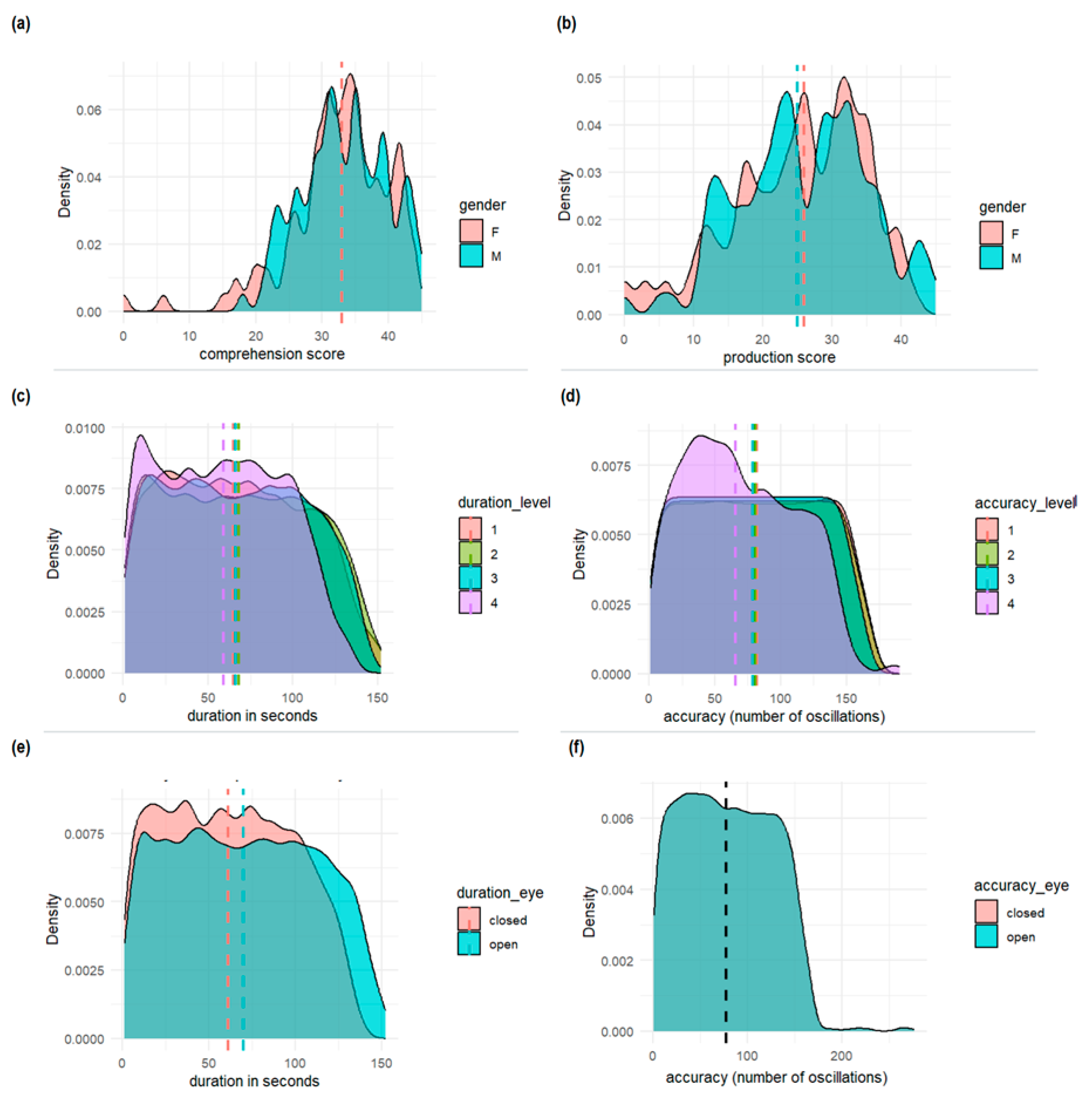
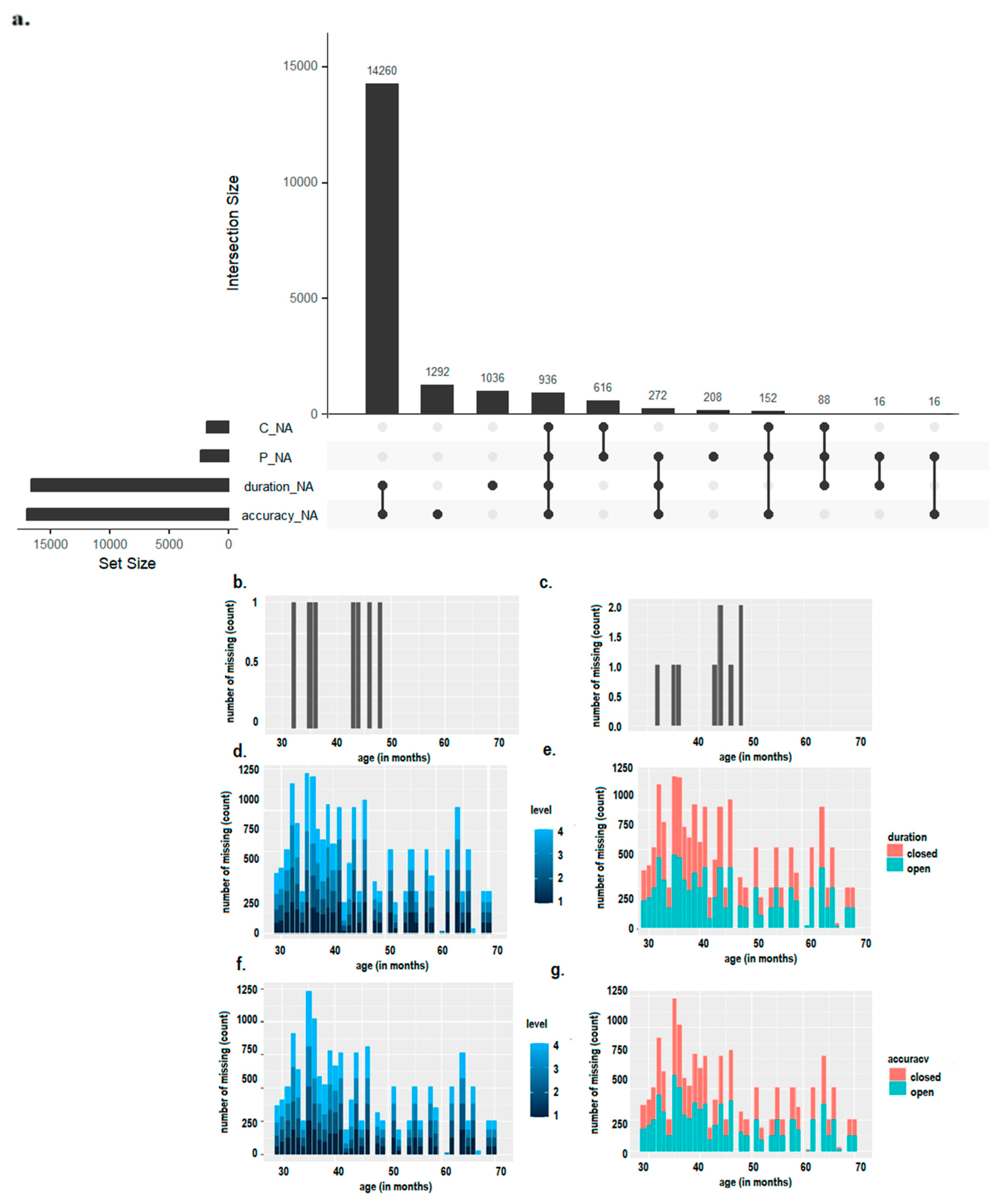
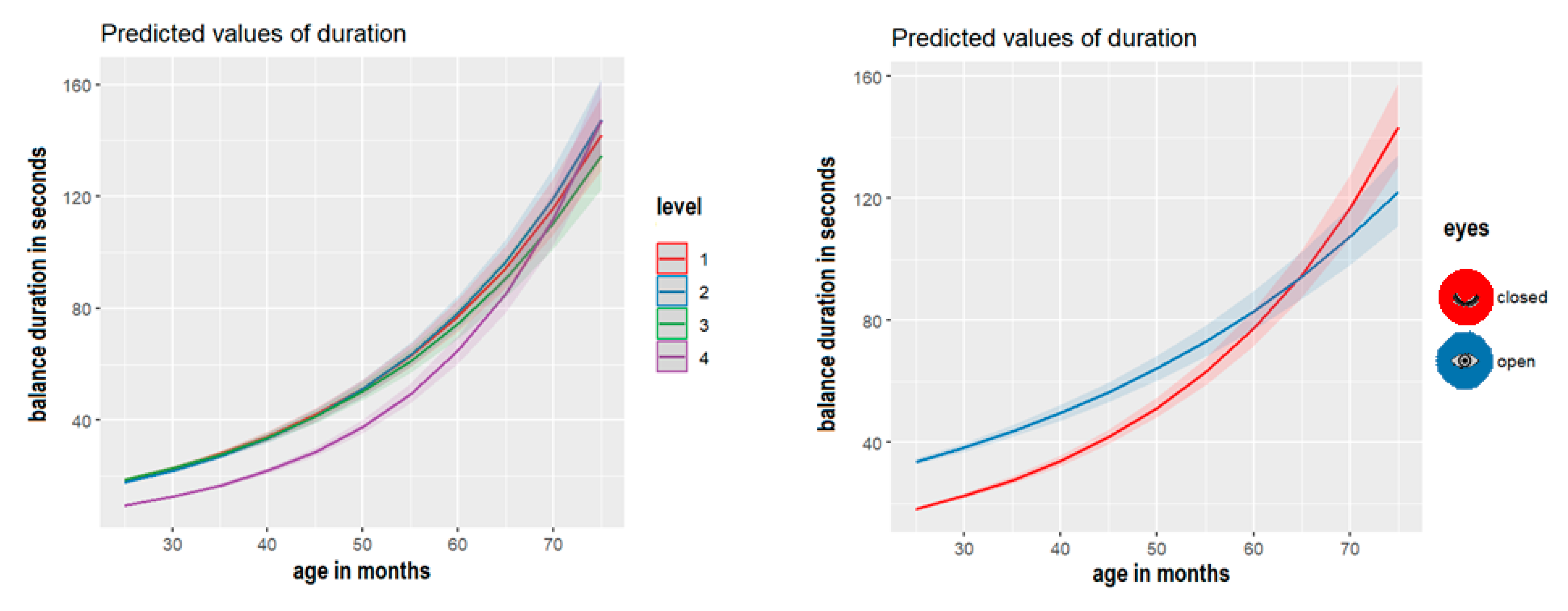
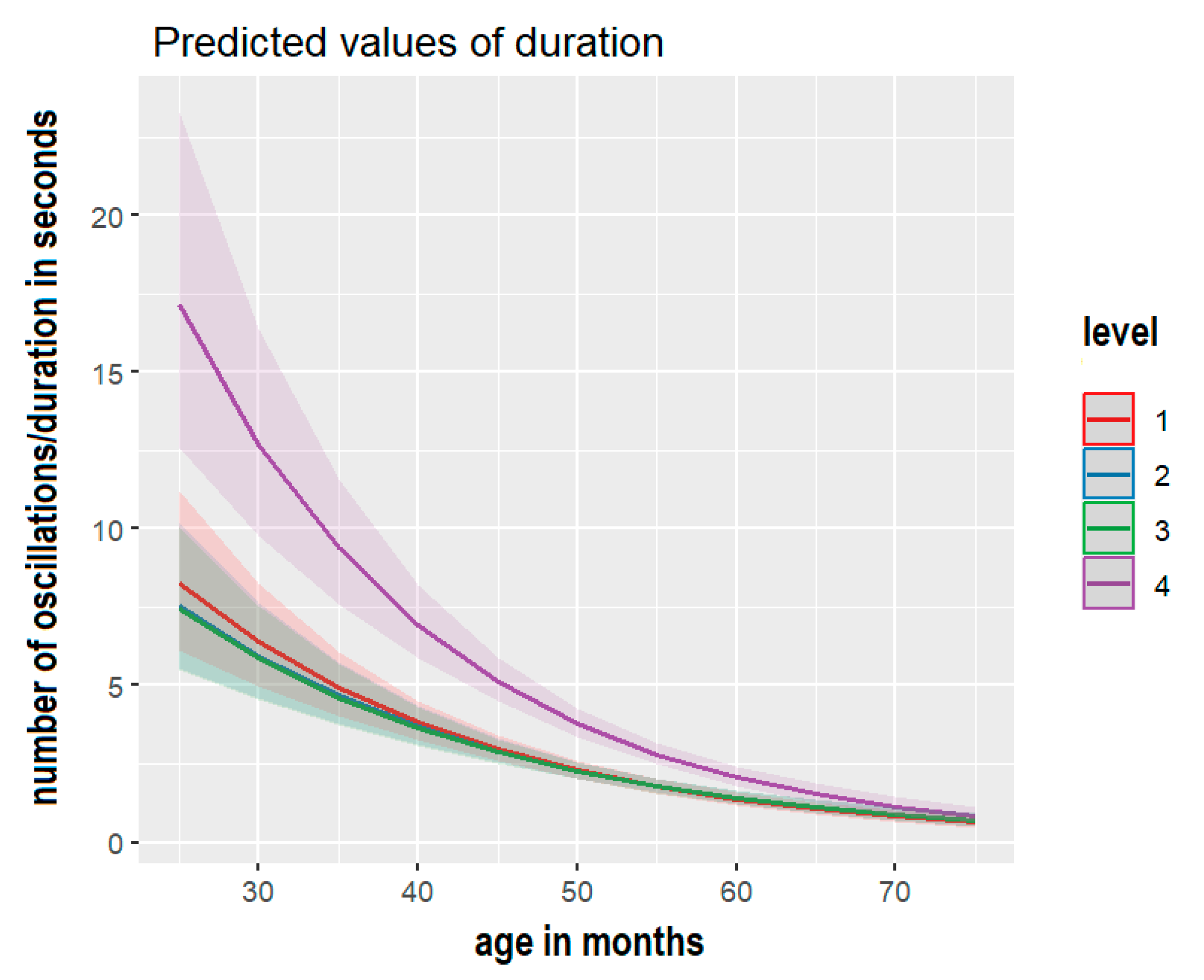
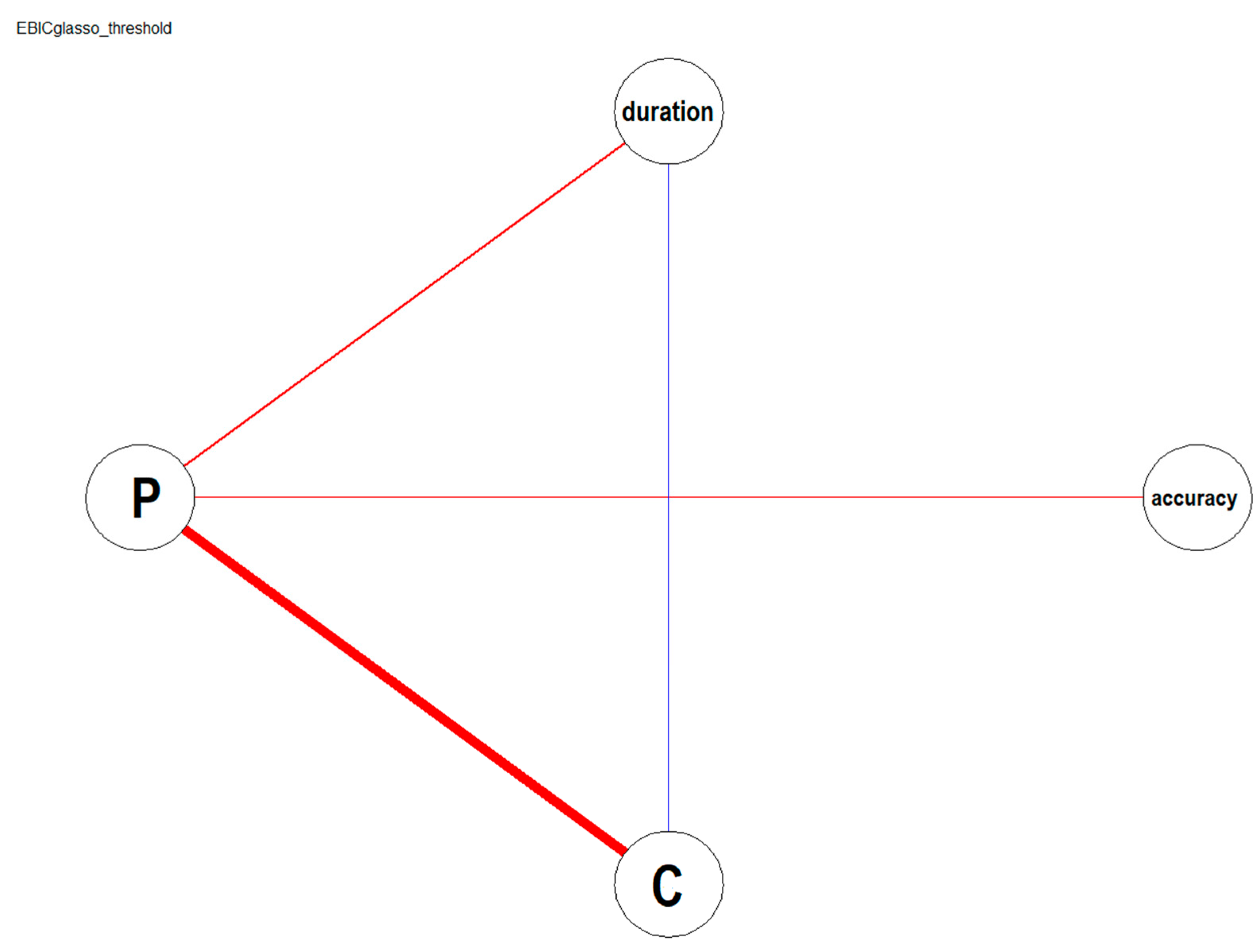

| Predictors | Estimates | Std. Error | p |
|---|---|---|---|
| (Intercept) | 1.90 | 0.001 | <0.01 |
| age | 0.04 | 0.002 | <0.01 |
| duration level (2) | −0.08 | 0.001 | <0.01 |
| duration level (3) | 0.04 | 0.001 | <0.01 |
| duration level (4) | −0.99 | 0.001 | <0.01 |
| duration eye (open) | 0.99 | 0.001 | <0.01 |
| age * duration level (2) | 0.002 | 0.0001 | <0.01 |
| age * duration level (3) | −0.001 | 0.0001 | <0.01 |
| age * duration level (4) | 0.01 | 0.0002 | <0.01 |
| age * duration eye (open) | −0.015 | 0.0001 | <0.01 |
| Random Effects | |||
| σ2 | 0.30 | ||
| τ00 id | 0.16 | ||
| τ11 id.duration_shapeU | 0.06 | ||
| ρ01 id | −0.55 | ||
| ICC | 0.35 | ||
| N id | 173 | ||
| Observations | 40,224 | ||
| Marginal R2/Conditional R2 | 0.266/0.525 |
| Predictors | Estimates | Std. Error | p |
|---|---|---|---|
| (Intercept) | 3.398 | 0. 285 | <0.001 |
| age | −5.138 | 0.547 | <0.001 |
| accuracy level (2) | −1.82 | 0.649 | 0.005 |
| accuracy level (3) | −2.00 | 0.649 | 0.002 |
| accuracy level (4) | 9.502 | 0.748 | <0.001 |
| accuracy eye (open) | 0.002 | 5.07 | 1.000 |
| age * accuracy level (2) | 3.57 | 1.21 | 0.003 |
| age * accuracy level (3) | 3.73 | 1.21 | 0.002 |
| age * accuracy level (4) | −8.88 | 1.36 | <0.001 |
| age * accuracy eye (open) | −0.005 | 9.48 | 1.000 |
| Random Effects | |||
| σ2 | 1.47 | ||
| τ00 id | 0.85 | ||
| ICC | 0.37 | ||
| N id | 171 | ||
| Observations | 38,764 | ||
| Marginal R2/Conditional R2 | 0.115/0.440 |
Disclaimer/Publisher’s Note: The statements, opinions and data contained in all publications are solely those of the individual author(s) and contributor(s) and not of MDPI and/or the editor(s). MDPI and/or the editor(s) disclaim responsibility for any injury to people or property resulting from any ideas, methods, instructions or products referred to in the content. |
© 2023 by the authors. Licensee MDPI, Basel, Switzerland. This article is an open access article distributed under the terms and conditions of the Creative Commons Attribution (CC BY) license (https://creativecommons.org/licenses/by/4.0/).
Share and Cite
Calignano, G.; Lettere, G.; Leo, I.; Maritan, F.; Mattera, L.; Granata, P.; Lucangeli, D.; Valenza, E. Interconnected Pathways: Postural Stability and Vocabulary Skills in Preschool-Aged Children. Children 2023, 10, 1891. https://doi.org/10.3390/children10121891
Calignano G, Lettere G, Leo I, Maritan F, Mattera L, Granata P, Lucangeli D, Valenza E. Interconnected Pathways: Postural Stability and Vocabulary Skills in Preschool-Aged Children. Children. 2023; 10(12):1891. https://doi.org/10.3390/children10121891
Chicago/Turabian StyleCalignano, Giulia, Giorgia Lettere, Irene Leo, Francesca Maritan, Laura Mattera, Patrizia Granata, Daniela Lucangeli, and Eloisa Valenza. 2023. "Interconnected Pathways: Postural Stability and Vocabulary Skills in Preschool-Aged Children" Children 10, no. 12: 1891. https://doi.org/10.3390/children10121891
APA StyleCalignano, G., Lettere, G., Leo, I., Maritan, F., Mattera, L., Granata, P., Lucangeli, D., & Valenza, E. (2023). Interconnected Pathways: Postural Stability and Vocabulary Skills in Preschool-Aged Children. Children, 10(12), 1891. https://doi.org/10.3390/children10121891






